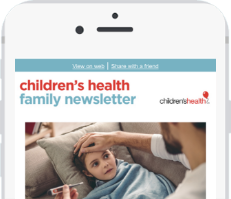Most people don’t think of kids at the mention of stroke. However, a stroke can occur at any age and, it’s one of the top 10 causes of death in children.
What is a stroke?
A stroke is an unexpected interruption of blood flow to the brain which can affect movement, speech and cognitive thinking. In children, strokes are more often due to blood clotting problems, congenital heart disease, infections or other long term conditions like Sickle Cell Disease.
Read more information on types of strokes.
How common is childhood stroke?
“It’s more common than most parents and doctors realize. In fact, stroke occurs as often as leukemia and brain tumors in children.” says Michael Dowling, MD, PhD, Pediatric Neurologist and Medical Director of the Pediatric Stroke Clinic at Children’s Health℠. “The good news is that children tend to recover faster and more fully from a neurological injury like stroke.”
The risk of stroke from birth through age 18 is approximately 11 per 100,000 children. However, it’s most commonly seen before a child is 2.
What are the symptoms of stroke in children?
These warning signs usually come on suddenly:
- Severe headache, especially with vomiting and sleepiness
- Weakness or numbness on one side of the body (face, arm and/or leg)
- Confusion with difficulty speaking or understanding others
- Trouble seeing to one side, loss of vision or double vision
- Difficulty walking, dizziness, loss of balance or lack of coordination
- New-onset of seizures, usually on one side of the body
Signs that may indicate a stroke as your child grows
60% of infants with a stroke diagnosis have specific symptoms such as recurrent focal seizures in the first three days after birth. However, 40% of infants with early stroke do not have symptoms and the stroke is recognized later with delays in development, movement, learning or seizures. The signs below may indicate a child has had a previous stroke:
- Favors one hand before 1 year of age, leaves the other hand in a fist or doesn’t bring both hands together during play.
- Delays in early milestones – rolling, sitting, pulling to stand, crawling and walking.
- May be unwilling to bear weight on one leg, may point the toes on that foot or walk on tip toe.
What to do if you suspect your child is having a stroke
Early identification and intervention are critical, call 911 if your child suddenly has one or more of these symptoms:
- Balance – Is there a sudden change in their balance or coordination?
- Eyes – Are they experiencing blurred vision or double vision or sudden and lasting vision trouble?
- Face – Ask the child to smile. Is one or both sides of their face drooping or sagging?
- Arms – Ask the child to raise both arms. Does one side drift downward or appear weak? Is there numbness on one side?
- Speech – Does the child have slurred speech or have trouble speaking the way they normally would? Can he/she repeat words and phrases?
- Time – Call 911 immediately if you notice one or more of these signs and be sure to share when you first noticed them.
Learn more
The Center for Cerebrovascular Disorders at Children’s Health brings together a multidisciplinary team that includes experts in pediatric neurology, neurosurgery, neuroradiology, interventional radiology, hematology, emergency medicine, neuropsychology, physical and occupational therapy, speech and language therapy and Physical Medicine and Rehabilitation. This team treats and cares for children of all ages and every stage of stroke, from acute care in the emergency department through long-term follow-up, rehabilitation and planning for each child’s educational needs.

Thank you!
You are now subscribed to the Children's Health Family Newsletter.
Children's Health will not sell, share or rent your information to third parties. Please read our privacy policy.
Source references: www.chasa.org; www.stroke.org
